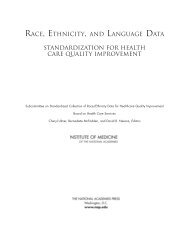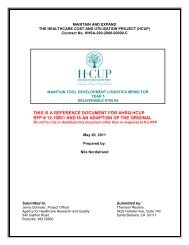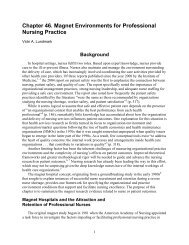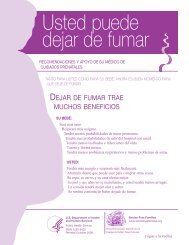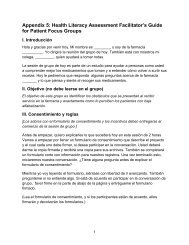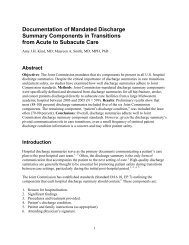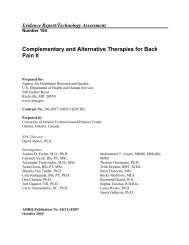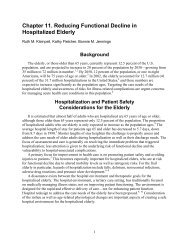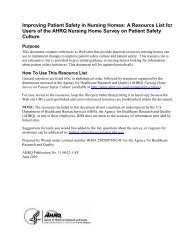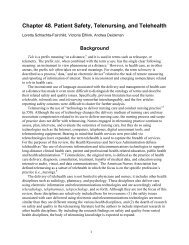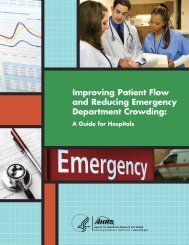Emergency Severity Index (ESI): A Triage Tool for Emergency ...
Emergency Severity Index (ESI): A Triage Tool for Emergency ...
Emergency Severity Index (ESI): A Triage Tool for Emergency ...
You also want an ePaper? Increase the reach of your titles
YUMPU automatically turns print PDFs into web optimized ePapers that Google loves.
Chapter 4. <strong>ESI</strong> Levels 3-5 and Expected<br />
Resource Needs<br />
Traditionally, comprehensive triage has been the<br />
dominant model <strong>for</strong> triage acuity assignment in U.S.<br />
emergency departments (Gilboy, 2010; Gilboy,<br />
Travers, & Wuerz, 1999). <strong>Triage</strong> acuity rating systems<br />
have been based solely on the acuity of the patient,<br />
determined through the nurse's assessment of vital<br />
signs, subjective and objective in<strong>for</strong>mation, past<br />
medical history, allergies, and medications. Such<br />
systems require the nurse to assign an acuity level<br />
by making a judgment about how sick the patient is<br />
and how long the patient can wait to be seen by a<br />
provider.<br />
The <strong>ESI</strong> triage system uses a novel approach that<br />
includes not only the nurse’s judgments about who<br />
should be seen first, but also, <strong>for</strong> less acute patients<br />
(those at <strong>ESI</strong> levels 3 through 5), calling on the<br />
nurse to add predictions of the resources that are<br />
likely to be used to make a disposition <strong>for</strong> the<br />
patient.<br />
This chapter includes background in<strong>for</strong>mation on<br />
the inclusion of resource predictions in the <strong>ESI</strong> and<br />
a description of what constitutes a resource.<br />
Examples are given of patients rated <strong>ESI</strong> levels 3 to 5<br />
and the resources that each patient is predicted to<br />
need.<br />
Estimation of resource needs begins only after it has<br />
been determined that the patient does not meet <strong>ESI</strong><br />
level 1 or 2 criteria. The nurse then predicts the<br />
number of resources a patient will need in order <strong>for</strong><br />
a disposition to be reached. When Wuerz and Eitel<br />
created the <strong>ESI</strong> triage system, they included resource<br />
utilization to provide additional data and allow a<br />
more accurate triage decision. They believed that an<br />
experienced emergency department (ED) triage<br />
nurse would be able to predict the nature and<br />
number of tests, therapeutic interventions, and<br />
consultations that a patient would need during<br />
his/her ED stay. Studies of <strong>ESI</strong> implementation and<br />
validation have verified that triage nurses are able to<br />
predict ED patients’ resource needs (Eitel, Travers,<br />
Rosenau, Gilboy, & Wuerz, 2003; Tanabe, Gimbel,<br />
Yarnold, & Adams, 2004). One study was conducted<br />
at seven EDs representing varied regions of the<br />
country, urban and rural areas, and academic and<br />
community hospitals. Nurses were able to predict<br />
how many <strong>ESI</strong>-defined resources the ED patients<br />
required 70 percent of the time. That is, experienced<br />
triage nurses can reasonably predict at triage how<br />
many resources patients will require to reach ED<br />
29<br />
disposition; more importantly, they can discriminate<br />
at presentation low versus high resource intensity<br />
patients. This differentiation by resource<br />
requirements allows <strong>for</strong> much more effective<br />
streaming of patients at ED presentation into<br />
alternative operational pathways within the ED, that<br />
is, the parallel processing of patients. Research has<br />
also established that <strong>ESI</strong> triage levels correlate with<br />
important patient outcomes, including admission<br />
and mortality rates (Eitel et al., 2003).<br />
Again, it is important to note that resource prediction<br />
is only used <strong>for</strong> less acute patients. At decision points A<br />
and B on the <strong>ESI</strong> algorithm (Figure 4-1), the nurse<br />
decides which patients meet criteria <strong>for</strong> <strong>ESI</strong> levels 1<br />
Figure 4-1. <strong>ESI</strong> <strong>Triage</strong> Algorithm, v. 4<br />
©<strong>ESI</strong> <strong>Triage</strong> Research Team, 2004. Reproduced with<br />
permission.



